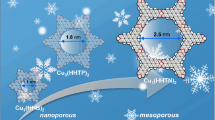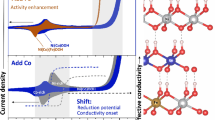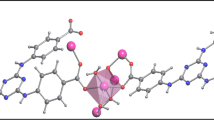Abstract
An ion-pair complex [Ni(o-phen)3][Ni(L)2]2.CH2Cl2 (1) [L = 1,2-diphenylethylene-1,2-dithiolate, o-phen = 1,10-phenanthroline] has been synthesized and X-ray crystallographically characterized. The solution structure of 1, as derived from cyclic voltammetry, conforms well to the solid-state molecular structure. The redox peaks obtained from the electrochemical analysis of 1 are to some extent a combination of the peaks obtained individually for [Ni(o-phen)3]2+ and [Ni(L)2]. Moreover, the reaction protocol for the synthesis of the title complex by the addition of o-phen to [Ni(L)2] is analyzed electrochemically. 1 conducts electricity in solid-state. The electrical conductivity varied on varying temperatures from 308 K (35 °C) to 423 K (150 °C). The compound is found to be thermally unstable after 150 °C.
Graphical abstract
An ion-pair complex [Ni(o-phen)3][Ni(L)2]2.CH2Cl2 (1) [L = 1,2-diphenylethylene-1,2-dithiolate] has been synthesized and characterized by X-ray crystallography. On electrochemical characterization in solution, the redox peaks (reduction) obtained from the cyclic voltammetry of 1 are found to be a combination of the peaks obtained individually for [Ni(o-phen)3]2+ and [Ni(L)2]. 1 also conducts electricity in a solid state like a semiconducting material.
















Similar content being viewed by others
References
(a) Clough A J, Skelton J M, Downes C A, de la Rosa A A, Yoo J W, Walsh A, Melot B C and Marinescu S C 2017 Metallic Conductivity in a Two-Dimensional Cobalt Dithiolene Metal–Organic Framework J. Am. Chem. Soc. 139 10863; (b) Dutta A, Chatterjee A, Sarkar T, Chowdhury S, Kamble V B and Ghosh R 2021 Synthesis, structural characterization and variable temperature electrical conductivity of a pentanuclear Pd(II)dithiolato complex Inorg. Chem. Commun. 133 108889
Madhu V and Das S K 2008 New Series of Asymmetrically Substituted Bis(1,2-dithiolato)-Nickel(III) Complexes Exhibiting Near IR Absorption and Structural Diversity Inorg. Chem. 47 5055
Attar SS, Pilia L, Espa D, Artizzu F, Marinotto D, Marchiò L and Deplano P 2021 Insight into the Properties of Heteroleptic Metal Dithiolenes: Multistimuli Responsive Luminescence, Chromism, and Nonlinear Optics Inorg. Chem. 60 9332
Hine F J, Taylor A J and Garner C D 2010 Dithiolene complexes and the nature of molybdopterin Coord. Chem. Rev. 254 1570
(a) Stiefel E I 1996 Molybdenum bolsters the bioinorganic brigade Science 272 1599; (b) Westcott B L, Gruhn N E and Enemark J 1998 Evaluation of Molybdenum−Sulfur Interactions in Molybdoenzyme Model Complexes by Gas-Phase Photoelectron Spectroscopy. The “Electronic Buffer” Effect J. Am. Chem. Soc. 120 3382
(a) Downes C A and Marinescu S C 2016 One dimensional metal dithiolene (M = Ni, Fe, Zn) coordination polymers for the hydrogen evolution reaction Dalton Trans. 45 19311; (b) Chen K, Downes C A, Goodpaster J D and Marinescu S C 2021 Hydrogen evolving activity of dithiolene based metal-organic frameworks with mixed cobalt and iron centers Inorg. Chem. 60 11923; (c) Zhang Z, Yang T, Qin P and Dang L 2018 Nickel bis(dithiolene) complexes for electrocatalytic hydrogen evolution: a computational study J. Organomet. Chem. 864 143; (d) Niu Z, Yang L, Xiao Y, Xue M, Zhou J, Zang L, Wilkinson D P and Ni C 2022 Novel dithiolene nickel complex catalysts for electrochemical hydrogen evolution reaction for hydrogen production in nonaqueous and aqueous solutions Electrocatalysis 13 230
Faulmann C and Cassoux P 2004 Solid-State Properties (Electronic, Magnetic, Optical) of Dithiolene Complex-Based Compounds In: Dithiolene Chemistry: Synthesis, Properties and Applications K D Karlin and E I Stiefel (Eds.) (Hoboken, New Jersey: John Wiley & Sons) Ch. 8 pp. 399-490
Dutta A, Chatterjee A, Bhar K, Banerjee A and Ghosh R 2019 Synthesis, structure and solid-state electrical conductivity of bis(1,2-diphenylethylene-1,2-dithiolate)nickel(II) J. Chem. Sci. 131 84
Kemp W 2008 Organic Spectroscopy 3rd Edition (reprinted 2008) (Basingstoke Hampshire: PALGRAVE Publication) Ch. 2, Infrared Spectroscopy, pp. 19–99
Miao Q, Gao J, Wang Z, Yu H, Luo Y and Ma T 2011 Synthesis and characterization of several nickel bis(dithiolenes) complexes with strong and broad Near-IR absorption Inorg. Chim. Acta 376 619
Arounaguiri S, Easwaramoorthy D, Ashokkumar A, Dattagupta A and Maiya B G 2000 Cobalt(III), nickel(II) and ruthenium(II) complexes of 1,10-phenanthroline family of ligands: DNA binding and photocleavage studies Proc. Indian Acad. Sci. (Chem. Sci.) 112 1
Dolomanov O V, Bourhis L J, Gildea R J, Howard J A K and Puschmann H 2009 OLEX2: a complete structure solution, refinement and analysis program J. Appl. Cryst. 42 339
Sheldrick G M 2015 SHELXT - Integrated space-group and crystal-structure determination Acta Cryst. A 71 3
Sheldrick GM 2015 Crystal structure refinement with SHELXL Acta Cryst. C 71 3
Farrugia L J 1998 ORTEP-32 for windows (University of Glasgow: Scotland)
Zarkadoulas A, Field M J, Papatriantafyllopoulou C, Fize J, Artero V and Mitsopoulou C A 2016 Experimental and theoretical insight into electrocatalytic hydrogen evolution with nickel bis(aryldithiolene) complexes as Catalysts Inorg. Chem. 55 432
Smith W H and Kuo Y-M 1985 Electrochemical studies of nickel tris(phenanthroline) in nonaqueous solvents: Part I. General electrochemical behaviot and catalytic reactions of low valent species with alkyl and aryl bromides J. Electroanal. Chem. 188 189
Kobayashi A, Tanaka H, Kumasaki M, Torii H, Narymbetov B and Adachi T 1999 Origin of the high electrical conductivity of neutral [Ni(ptdt)2] (ptdt2- = propylenedithiotetrathiafulvalenedithiolate): a route to neutral molecular metal J. Am. Chem. Soc. 121 10763
Acknowledgements
One of the authors (AD) is thankful to CSIR, India for his fellowship and contingency grants. The authors are also thankful to Dr. Subhrajyoti Bhandary, FWO Researcher, Department of Chemistry, Ghent University, Belgium for several crystallographic discussions. The mass spectral measurement from Central Research Facility, IIT Ropar, India is gratefully acknowledged.
Author information
Authors and Affiliations
Corresponding authors
Additional information
Arghya Dutta: The present work is dedicated to the memories of this author who very suddenly passed away during the revision process of this manuscript.
Supplementary Information
Below is the link to the electronic supplementary material.
Rights and permissions
About this article
Cite this article
Dutta, A., Mahanta, A., Panda, S.J. et al. Synthesis, X-ray structural characterization, and electrochemical investigations on a semiconducting Ni(II) dithiolate with tris(1,10-phenanthroline)nickel(II) as counter-cation. J Chem Sci 135, 62 (2023). https://doi.org/10.1007/s12039-023-02179-w
Received:
Revised:
Accepted:
Published:
DOI: https://doi.org/10.1007/s12039-023-02179-w




